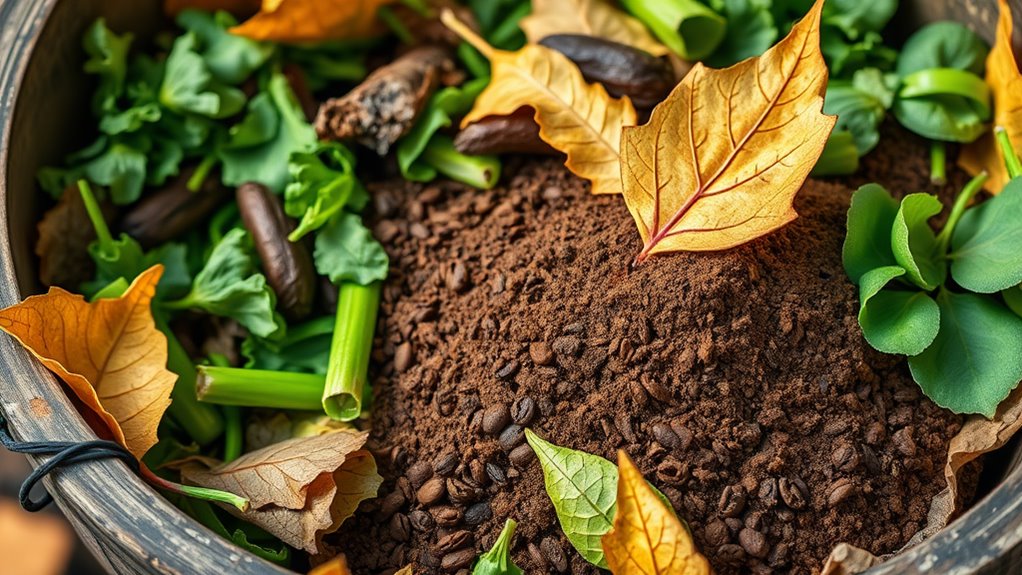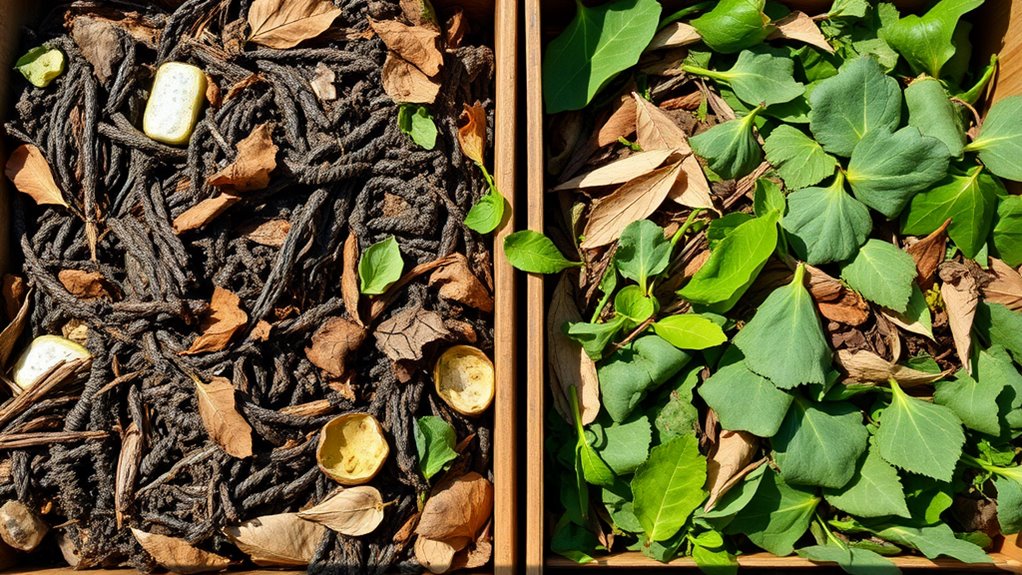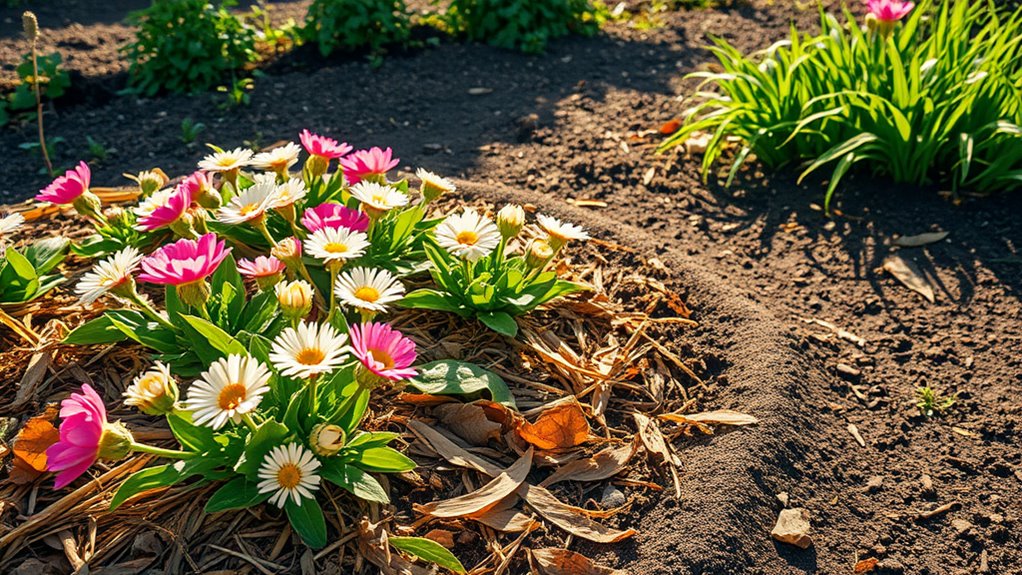Compost Like a Pro With This Simple Ingredient Swap
You’ve got to master composting like a pro with this simple swap: aim for a 2:1 ratio of carbon-rich browns to nitrogen-packed greens. This balance accelerates decomposition, prevents odors, and produces nutrient-rich humus for healthier soil. You’ll avoid common pitfalls by selecting the best materials and maintaining it easily. Explore these tips to unlock even greater gardening success.
Key Takeaways
- Maintain a 2:1 ratio of browns to greens for balanced composting.
- Swap coffee grounds or vegetable peels for nitrogen-rich greens to boost decomposition.
- Use shredded newspaper or straw as carbon-heavy browns to prevent excess moisture.
- Layer materials alternately and turn the pile every few days for optimal aeration.
- Monitor moisture daily to keep the compost at a wrung-out sponge consistency.
The Essential Ingredient Swap
If you’re composting like a pro, you’ll need to master the essential ingredient swap, which means balancing nitrogen-rich “greens” like kitchen scraps with carbon-heavy “browns” like dried leaves.
To perfect this, try these composting hacks: Chop greens into smaller pieces for faster breakdown—you’ll speed up the process.
Layer browns evenly to avoid clumping; it prevents odors and maintains airflow. Always aim for a 2:1 browns-to-greens ratio by volume.
Monitor moisture; add browns if it’s too wet, or greens if it’s dry. These tweaks ensure your pile decomposes efficiently, turning waste into gold. By making this ingredient swap, you can also achieve richer soil for better gardening results.
Additionally, by incorporating kitchen scraps and garden waste, you can further enhance soil health and support sustainable gardening practices.
Why This Swap Boosts Your Compost
Understanding why the ingredient swap—balancing nitrogen-rich greens with carbon-heavy browns—boosts your compost starts with its core benefits.
This balance optimizes the carbon-to-nitrogen ratio, fueling microbial activity for faster decomposition. You’ll accelerate breakdown processes, turning waste into nutrient-rich humus more efficiently.
It prevents common issues like foul odors or excess moisture, keeping your pile healthy and manageable. By maintaining this equilibrium, you’re fostering a thriving ecosystem that produces high-quality compost, enhancing soil fertility and supporting robust plant growth without unnecessary complications.
Moreover, by utilizing everyday kitchen scraps, you can transform your trash into garden gold, promoting healthier plants and a more sustainable garden. This approach draws from effective composting techniques to maximize your garden’s potential.
Selecting the Best Alternatives
Now that you’ve mastered the balance of greens and browns, it’s time to identify top alternatives that keep your compost thriving.
When selecting greens, opt for coffee grounds or vegetable peels for their high nitrogen content, which accelerates decomposition and boosts nutrients.
For browns, choose shredded newspaper or straw to provide carbon while improving aeration and preventing compaction.
Always prioritize locally sourced, pesticide-free options to avoid contaminants and ensure sustainability. For busy beginners, low-effort methods can simplify the process while still yielding excellent results.
This focused approach maintains a robust, efficient compost pile, supporting your gardening goals effectively.
By implementing these tips from easy composting routines, you can produce nutrient-rich black gold soil for your garden.
Step-by-Step Implementation Guide
To implement your composting system effectively, start by gathering materials like a bin, greens, and browns based on your earlier selections. To prevent setbacks, always consider learning from composting mistakes that could impact your garden’s success.
Choose a well-drained spot, then layer browns at the bottom for airflow. Add greens next, aiming for a balanced mix to kickstart decomposition.
Moisten the pile lightly—it’s crucial for microbial activity. Turn the compost every few days using a pitchfork to incorporate air and distribute moisture evenly.
Monitor the temperature; it should warm up as it breaks down. Additionally, watch for common composting issues that could affect your pile, such as odors or slow decomposition, to maintain a healthy process. Adjust layers if the pile gets too dry or compacted, ensuring even breakdown over time.
Key Benefits for Soil Health
Composting transforms your soil by boosting its nutrient content, making it richer and more fertile for your plants. This approach, inspired by natural soil preparation techniques, can significantly enhance your harvest while promoting healthier plants and increased yield without the need for fertilizers.
You’ll notice improved structure and vitality, thanks to that simple ingredient swap, which fosters a balanced ecosystem without extra effort.
-
Enhances microbial activity****: It populates your soil with beneficial organisms that break down materials efficiently, supporting plant roots.
-
Improves water retention****: Your soil holds moisture better, reducing irrigation needs and preventing erosion.
-
Boosts nutrient cycling****: Essential elements like nitrogen and phosphorus become more available, promoting robust growth and resilience.
By incorporating homemade alternatives, you can adopt sustainable practices that reduce reliance on store-bought fertilizers and promote a thriving garden ecosystem.
Optimizing Decomposition Efficiency
While achieving optimal decomposition demands careful balance, you’ll accelerate your compost pile’s process by mixing greens and browns in equal parts, maintaining ideal moisture levels, and aerating regularly. Remember, using suitable materials is essential for beginners mastering composting in small spaces.
Greens like kitchen scraps provide nitrogen, while browns such as leaves add carbon for a balanced microbial feast.
Monitor moisture to keep it damp but not soggy—think of a wrung-out sponge.
Turn your pile every few days to oxygenate it, fostering faster breakdown and richer compost.
Track progress by temperature; a warm pile signals efficient activity, yielding nutrient-packed results in weeks.
Stay consistent for peak efficiency.
To enhance your soil naturally, consider using backyard solutions like fallen leaves and kitchen scraps for even more effective composting.
Avoiding Common Composting Pitfalls
Even though composting seems straightforward, you’ll often encounter pitfalls that can slow your pile or attract pests if you’re not careful. These issues can derail your efforts, but simple strategies keep things on track.
-
Balance your materials: Overloading greens (like kitchen scraps) without enough browns (like dried leaves) creates a smelly, sluggish pile—aim for a 2:1 browns-to-greens ratio to maintain airflow and speed decomposition.
-
Control moisture levels: Too much water turns your compost into a soggy mess that fosters bad bacteria, while dryness halts breakdown—keep it as moist as a wrung-out sponge for optimal results.
-
Select appropriate additions: Adding meat, dairy, or oily foods invites pests and odors, so stick to plant-based wastes to protect your pile and promote clean decomposition.
Daily Maintenance Tips
Daily maintenance is key to keeping your compost pile healthy and efficient.
You’ll need to turn it every couple of days to promote aeration and mix materials evenly, preventing clumping.
Check moisture levels daily; if it’s too dry, add water until it’s like a wrung-out sponge, but don’t overdo it to avoid sogginess.
Balance your greens and browns as you add kitchen scraps, aiming for a 2:1 ratio to control odors.
Monitor for pests or foul smells, removing any problematic items immediately.
This routine ensures faster decomposition and nutrient-rich results.
Advanced Hacks for Superior Results
You’ve mastered the basics, so let’s elevate your composting with advanced hacks like proper layering and optimal aeration.
Start by fine-tuning your advanced layering to create a balanced, nutrient-rich pile that decomposes efficiently.
Then, ensure optimal aeration by turning your compost regularly, boosting microbial activity for faster results.
Advanced Layering
While basic composting relies on simple layers, mastering advanced techniques lets you optimize your pile for faster breakdown and richer results.
Advanced layering helps you balance nutrients and moisture more precisely, turning your compost into a high-performance system.
-
Strategically alternate materials: Stack thin layers of greens (like vegetable scraps) and browns (such as dried leaves) in a 2:1 ratio to speed up decomposition without excess bulk.
-
Incorporate activators: Add compost starters or manure between layers to boost microbial activity and enhance nutrient density.
-
Monitor and adjust layers: Regularly check your pile’s temperature and texture, fine-tuning additions to ensure even breakdown and superior soil amendment.
Optimal Aeration
Optimal aeration keeps your compost pile thriving by ensuring oxygen flows freely, accelerating decomposition and warding off foul smells.
As a pro, you’ll turn the pile every three to five days using a pitchfork, mixing materials to distribute air evenly and prevent compaction.
Add bulky items like straw or twigs to create essential air pockets, maintaining porosity for better airflow.
Monitor temperature and moisture regularly; if the pile cools or smells off, aerate immediately.
These hacks speed up breakdown, reduce odors, and yield nutrient-rich compost, elevating your gardening game with minimal effort.





